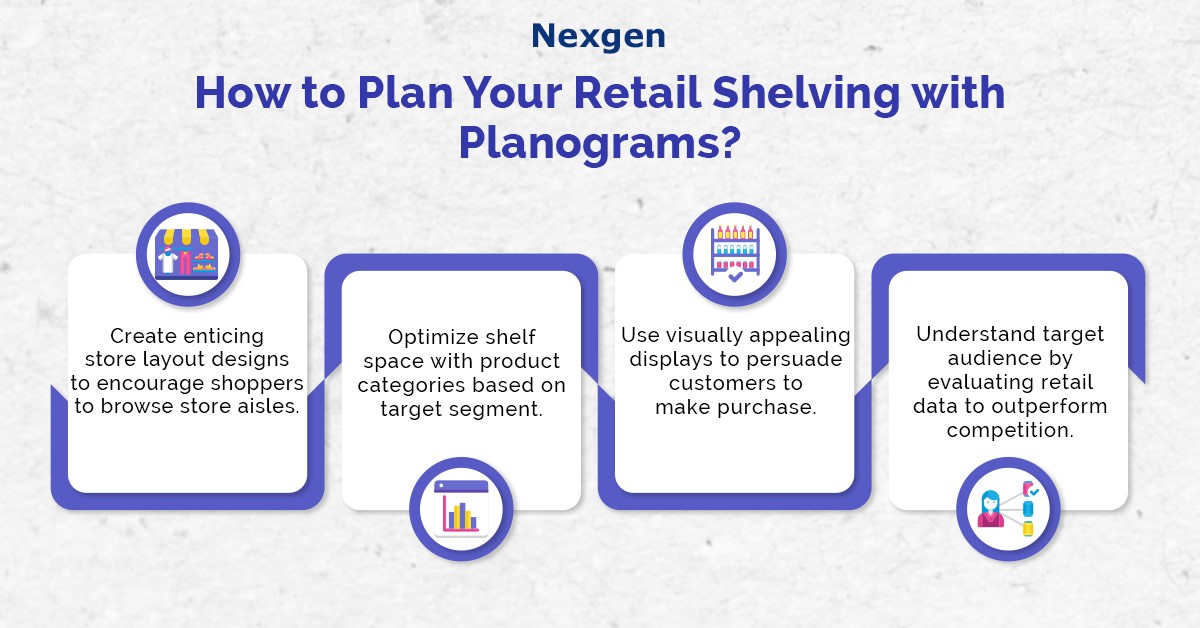When designing the space of your retail store, be careful of the placement of your retail shelves. Your shelving can enhance the overall layout of your store and create an enticing shopping experience for customers. Retailers across the world use visual merchandising solutions like planograms to plan the placement of items on retail shelves and keep the stores efficient.
Although the retail business is rapidly changing in response to technology, one thing that remains constant is your retail design. How you use your available shelf space will impact both the shopper experience and in-store sales. In turn, this will impact your shopper’s buying behavior and how the customer interacts with your products on store shelves. Let us say, for example, a superstore or hypermarket. These stores have various products, ranging from economy to premium, that meet the needs of all shoppers. How will you convince your customers to shop at your store? You can entice shoppers with proper shelf planning using planograms by rightly placing products on store shelves. As a retailer, always make sure you can answer the following questions to boost your sales.

1. How much shelf space do you have in-store?
The size of the store depends on how much space is available to work with. Thus, the products you stock on store shelves must match the size of your store. For example, if you have a small store, the products displayed must be able to visually highlight your merchandise, without overwhelming your space. Then there are the category roles and strategies that you implement, ensuring customer-friendly stores. The roles you select can affect the shelves you use. How? Some categories will require more shelf space than others. For example, if you have a beauty store, and you notice that your ‘hair care’ category that includes shampoos, hair mists, and conditioners are the best-selling items among other beauty products, you want to have more shelf space for ‘hair care’ categories since they are constantly viewed and used by shoppers.
2. What type of shelving helps you display the products best?
When it comes to retail store shelving, you need to consider various factors like store layout design, inventory management, and types of shelving using planogram software. Consider these types of shelving to display the products to boost sales:
- Canned goods, food items and household cleaning supplies: The most flexible type of retail shelving for these products is gondola shelving. This is because all these forms of display make the best use of the given space in relation to the ability to effectively display various category-wise merchandise. As a result, supermarket stores frequently utilize this type of shelving.
- Beverages: Much like canned goods and food items, gondola shelving is best for displaying beverages to entice shoppers. Gondola shelving can hold beverages of large quantities and varying sizes, which make the shelf easily capture shopper attention.
- Clothing: Slatwalls, garment racks, gridwalls, and tables provide the greatest combinations with clothing. This is so that the merchandise can be displayed efficiently while still making the best possible use of the available space. This ensures you provide a stylish display of clothing to entice customers.
3. Does your store need more shelving in the future?
When selecting the retail shelving for your store, you should also consider the future. Trends are ever-changing and as a retailer, you need to stock items as per consumer demand. The stocking of various products in stores in the future might necessitate the use of various shelving arrangements. The shelving you use should be appropriate for your retail store and should present your products in a way that does not overwhelm the available space. The goal of owning a retail store is to expand, and it is crucial that the shelving you choose is suitable for any future growth. It is advisable to use customizable in-store displays using planograms if you are planning to expand or modify the store. Implementing versatile items is also essential. If your shelving is versatile, you can accommodate a wide range of products to expand or even add new departments. Lastly, if you plan to expand in the future, shelving that is easy to move around would be helpful since it would allow you to change the basic layout of your store.
Overview of Nexgen POG
Nexgen POG is a robust and user-friendly cloud-based visual merchandising tool. It is designed for quick and efficient planogramming with minimal effort. Planogram in retail can be designed by easily dragging and dropping the products. The multi-device compatibility feature of POG allows you to obtain, share and edit planogram on any device, including your phone. It helps in designing store-specific planograms for increased product visibility and sales.
Get Your Free Trial Now!